Occupational Environment Monitoring at the Rolling Door Manufacturing Plant
99,000 ₫
Note: The above price is calculated for one sample, and the price may vary depending on the area of the environment to be monitored and market fluctuations. For more accurate pricing support, please refer to the quotation table or contact our consulting staff directly.
Occupational environment monitoring at a rolling door manufacturing plant is a process of collecting, analyzing, and evaluating workplace factors that may harm workers’ health.
Table of Contents
Toggle1. Overview of Rolling Door Manufacturing Factories
a. What is a rolling door manufacturing factory?
Manufacturing factories for rolling doors are facilities specialized in producing and processing rolling doors, also known as automatic rolling doors. A rolling door is a type of door that can automatically open and close by rolling up or down, commonly used in residential and commercial structures such as shops, warehouses, factories, parking lots, and garages.

b. Production stages in rolling door manufacturing factories
Rolling door manufacturing factories usually have multi-step production and processing procedures, including the main stages as follows:
- Design and material cutting: This stage involves designing the rolling door based on customer requirements and cutting materials such as steel sheets or aluminum alloys in preparation for processing.
- Processing and welding: Steel sheets or aluminum alloys are processed and welded into door frames, including vertical bars, horizontal bars, and other mechanical components.
- Painting and finishing: The door frames and other components are coated to protect against corrosion and create an aesthetic finish. Painting may include powder coating or anti-rust painting.
- Assembly and inspection: Door frames and components are assembled into complete rolling doors, including mechanical parts, motors, and control systems. Then, the rolling doors are quality-checked to ensure compliance with customer standards and requirements.
- Packing and transportation: After completion, rolling doors are packed and prepared for shipment to the customer’s location.

c. Types of machinery used in rolling door manufacturing factories
In rolling door factories, various machines and equipment are used for processing and production. Common machinery includes:
- Metal cutting machines: Used to cut steel sheets or aluminum alloys into the required sizes and shapes for door frames and other components.
- Welding machines: Used to weld metal parts together, including spot welding and seam welding.
- Powder coating machines: Used to apply powder coating on metal surfaces for durability, corrosion resistance, and aesthetic finish.
- Pressing and bending machines: Used to press and bend steel sheets or aluminum alloys into different rolling door components, including vertical and horizontal bars.
- CNC processing machines: Used for precise machining of details and dimensions on door frames and other components.
- Automatic door cutting machines: Used to cut and work on rolling door panels, shaping them and adding special details as required.
- Packing and boxing machines: Used to pack finished rolling doors into suitable boxes or packaging for shipment and delivery.

d. Occupational diseases for workers in rolling door factories
Workers in rolling door manufacturing factories may be exposed to several occupational diseases related to their work environment and tasks. Common occupational diseases include:
- Respiratory diseases: Exposure to dust, chemical fumes, or liquids may cause respiratory issues such as pneumonia, asthma, sinusitis, and other respiratory problems.
- Spinal and musculoskeletal disorders: Lifting and transporting heavy metal components can lead to spine and joint problems such as vertebral degeneration, back pain, and arthritis.
- Workplace accidents: Accidents like cuts, punctures, crushing, fractures, and burns may occur when working with machinery and equipment.
- Skin diseases: Contact with chemicals, grease, and cleaning agents may cause dermatitis, skin irritation, eczema, or infections.
- Eye disorders: Work involving machinery, tools, and materials may strain eyes, causing visual fatigue, conjunctivitis, and dry eyes.
- Mental health issues: Work pressure, stressful conditions, and unsafe environments can lead to psychological stress, anxiety, depression, and other mental health concerns.

e. Common types of rolling doors on the market
Rolling doors are widely used in industrial and residential sectors. Some common types include:
- Aluminum rolling doors: Made from sturdy aluminum frames installed on rolling systems for opening and closing. They are lightweight, durable, and weather-resistant.
- Steel rolling doors: Made from solid steel material. Commonly used in industrial and warehouse settings for security and fire protection.
- Insulated rolling doors: Specially designed to provide insulation and maintain internal temperatures. Typically include insulation layers to reduce noise and save energy.
- High-speed rolling doors: Designed for rapid opening and closing, suitable for areas with high traffic such as parking lots, factories, supermarkets, and industrial facilities.
- Automatic rolling doors: Controlled by electronic or mechanical systems, allowing automatic opening and closing via sensors or buttons.
- Transparent rolling doors: Made from materials like tempered glass, polycarbonate, or other transparent materials, allowing natural light and visibility.
- High-speed doors: Open and close quickly, reducing waiting time and improving efficiency in high-traffic environments.
- Fire-resistant rolling doors: Designed to resist fire and prevent fire spread in case of emergencies.
2. Overview of occupational environment monitoring services
a. What is occupational environment monitoring in rolling door factories?
Occupational environment monitoring (or workplace environmental measurement) in rolling door factories involves collecting, evaluating, and analyzing metrics of workplace environmental factors in order to implement timely interventions, reduce environmental hazards to workers’ health, and prevent occupational diseases. Occupational environment monitoring is a mandatory requirement for rolling door factories.
It plays a critical role in protecting and enhancing workers’ health, as employees are the main resource generating profit for the business. Continuous exposure to hazardous factors exceeding allowed limits can negatively impact workers’ health and cause occupational diseases.
REGISTER FOR OCCUPATIONAL ENVIRONMENT MONITORING SERVICE
b. Nam Viet’s occupational environment monitoring program
Nam Viet’s occupational environment monitoring program is developed by engineers specializing in occupational safety and environmental protection. Aiming to ensure workers’ health and safety, the program uses modern measurement methods to monitor air quality, water, microclimate factors, physical conditions, dust, and more in the workplace. This program is essential for ensuring a safe working environment and protecting workers’ health.
Additionally, Nam Viet’s program plays a key role in researching and developing new solutions to improve workplace environmental quality. With the dedication and professionalism of its monitoring experts, Nam Viet’s proprietary program represents a breakthrough in occupational safety and environmental management in Vietnam.

c. Standardization in occupational environment measurement procedures
Standardization in Nam Viet’s occupational environment measurement procedures is vital to ensure accuracy and reliability. The program follows standards and recognized procedures by the Ho Chi Minh City Department of Health. This guarantees that the collected data is highly reliable for evaluating workplace conditions and making informed decisions to protect workers’ health.
These standardized procedures also ensure that measurements are conducted by highly qualified monitoring specialists with years of experience, allowing managers and experts to trust results from An Toàn Nam Việt and make accurate decisions valuable for workers’ health and environmental safety.
By applying standardization in occupational environment measurement, Nam Viet demonstrates its commitment to a safe working environment and contributes positively to improving occupational safety and environmental management in Vietnam.
d. Reporting results of rolling door factory monitoring
Monitoring results are prepared according to Form No. 04, Appendix III, issued with Decree 44/2016/ND-CP and is prepared in two copies: one sent to the enterprise that contracted the monitoring service, and one retained by the monitoring organization.
The retention period for occupational environment monitoring results is unlimited according to legal regulations.

e. Frequency of occupational environment monitoring according to the law
According to Clause 2 of Article 18, Law on Occupational Safety and Hygiene 84/2015/QH13, employers must conduct occupational environment monitoring to evaluate hazardous factors at least once a year.
f. Deadline for submitting occupational environment monitoring reports
Reports must be submitted before December 31 each year. Enterprises operating manufacturing facilities are required to submit monitoring results to the local Department of Health where the company’s headquarters and employees are located.
When there are changes in technology, production processes, or when renovating/upgrading workplaces that may generate new hazards to workers’ health, enterprises must update occupational safety records regarding harmful factors that require environmental monitoring.
g. Penalties for violations of occupational environment monitoring by employers
According to Article 27, Decree No. 12/2022/ND-CP dated 17/01/2022 on administrative penalties in labor, social insurance, and Vietnamese workers working abroad under contracts:
- Clause 2: A fine of VND 2,000,000 – 5,000,000 for employers who fail to publicly announce monitoring results and hazard management information to employees at the monitored workplace immediately after obtaining the results.
- Clause 3: A fine of VND 20,000,000 – 40,000,000 for employers who fail to conduct occupational environment monitoring to control health hazards according to legal regulations.
- Clause 4: A fine of VND 40,000,000 – 60,000,000 for employers who collude with monitoring organizations to commit fraud in monitoring activities without reaching criminal liability.
3. Harmful Environmental Factors for Workers in Roller Shutter Manufacturing Plants
Workers in roller shutter manufacturing plants may encounter several harmful environmental factors that can affect their health. Below are some environmental factors that may be harmful in roller shutter manufacturing workplaces:
- Dust and particles: The processing and fabrication of roller shutters can generate dust and airborne particles. Inhalation of dust and particles may cause respiratory irritation, pneumonia, and other health issues.
- Chemicals: The use of cleaning agents, additives, or adhesives during roller shutter production can release chemical fumes that may cause irritation or pose long-term health risks.
- Noise: Activities in roller shutter factories can produce significant noise levels. Continuous noise exposure may cause stress, insomnia, and negatively affect workers’ hearing health.
- Temperature and humidity: Working in environments with inappropriate temperature and humidity can affect workers’ comfort and work performance.
- Machinery safety: Using machinery and equipment during roller shutter production can be dangerous if safety procedures are not followed and personal protection is not ensured.
- Lighting: Lack of natural light or insufficient lighting in the workplace can cause eye strain and make work tasks more difficult.
- Workspace: Crowded or poorly ventilated work areas can restrict movement and increase the risk of collisions or workplace accidents.
REGISTER FOR OCCUPATIONAL ENVIRONMENT MONITORING SERVICE
4. Measures to Improve the Working Environment in Roller Shutter Manufacturing Plants
To improve the working environment in roller shutter factories and ensure workers’ health and safety, the following measures can be applied:
- Ensure ventilation and fan systems: Provide adequate airflow to clean the air and reduce humidity. Use fans or air purifiers to remove dust and airborne particles.
- Standardize work processes: Establish safe and efficient workflows, including guidance and training for workers on proper use of machinery and equipment.
- Use personal protective equipment (PPE): Ensure workers are provided with PPE such as safety glasses, masks, gloves, and ear protection to guard against dust, chemicals, noise, and other hazards.
- Control noise: Install soundproofing and insulation on machinery to reduce noise and maintain safe noise levels. Provide protective headphones to safeguard hearing.
- Ensure machinery and equipment safety: Maintain and inspect machinery regularly to ensure safe and efficient operation.
- Training and supervision: Provide training and instructions on safe work procedures, proper PPE use, and accident and occupational disease prevention. Conduct regular inspections and supervision to ensure compliance with safety regulations.
- Periodic air quality and workplace inspections: Conduct regular inspections to ensure air quality and the work environment meet safety standards and do not harm workers.
- Create a comfortable work environment: Ensure spacious, well-ventilated, and comfortable work areas. Improve natural lighting and use appropriate artificial lighting to reduce eye strain and enhance visibility.
- Establish safety policies and prioritize health: Set safety rules and encourage workers to participate in evaluating and improving the work environment.
- Periodically conduct occupational environment monitoring in factories, collect and analyze harmful factors for workers, and implement adjustments to reduce risks and prevent occupational diseases.
5. Benefits of Periodic Monitoring in Roller Shutter Manufacturing Plants
An Toan Nam Viet provides enterprises with excellent benefits when using occupational environment monitoring services according to Decree 44/2016/ND-CP on managing and controlling harmful factors in the working environment affecting employees.
- Enterprises can proactively control harmful factors in workshops or factories.
- Receive advice and recommendations on measures to minimize harmful factors and improve the working environment.
- Indirectly protect human resources, the key factor in business development.
- Reduce the impact of occupational diseases on health, lowering future treatment costs.
- Improve workers’ health, ensuring product quality and maintaining production output.
- Comply with occupational safety laws, avoiding legal risks.
- Enhance credibility and professionalism in all aspects, elevating the enterprise’s brand.
Nam Viet’s environmental monitoring service is a solution to minimize occupational disease risks, contributing to a clean and high-quality working environment.

6. Nationwide Occupational Environment Monitoring Center
The Occupational Environment Monitoring Center of Nam Viet is a professional unit specializing in supervising and measuring occupational environment quality across all provinces in Vietnam. With a team of experienced monitoring specialists, the center uses modern measurement equipment to ensure accuracy and reliability.
In addition to providing monitoring services, the center assists clients in planning, handling, and tracking occupational environment issues. With the motto “customers at the center,” the center prioritizes client satisfaction, meets all client needs, and commits to providing the best solutions for businesses.
REGISTER FOR OCCUPATIONAL ENVIRONMENT MONITORING SERVICE
With investments in technology, equipment, and personnel, Nam Viet’s monitoring center has become a reputable unit in occupational environment monitoring in Ho Chi Minh City, with the following objectives:
- We always value brand reputation and service quality.
- We provide clients with the best and most suitable solutions possible.
- Alongside a team of experienced Masters and Engineers committed to environmental protection and business benefit.
- By working with Nam Viet Environmental Monitoring, your company will receive professional service from field experts and enjoy the best cost advantages.
The occupational environment monitoring process at Nam Viet includes the following basic steps:
- Before monitoring, we ensure that all equipment is calibrated according to legal regulations.
- Strictly follow the occupational environment monitoring procedures committed to the Department of Health.
- Report monitoring results honestly to the employer.
- If results indicate unsafe conditions for workers, Nam Viet provides solutions, and the workplace will:
- Implement measures to improve working conditions to minimize harmful effects and prevent occupational diseases.
- Organize health examinations to detect occupational and work-related diseases early for employees in unsafe positions.
- Provide material compensation for workers according to labor law regulations.

7. Occupational Environment Monitoring Pricing
To help enterprises conduct professional and effective occupational environment monitoring, Nam Viet provides customers with a detailed and reasonably priced service quotation.
- Our pricing table provides detailed information on the costs of monitoring services, including travel, measurement, analysis, and reporting fees. Clients can rely on the accuracy and reliability of our monitoring reports.
- We commit to offering the most competitive and reasonable prices on the market and are always ready to provide fast and professional consultation on monitoring services.
- With Nam Viet’s quotation table, clients can easily select service packages that suit their needs. We guarantee maximum satisfaction with our professional service quality.
No comments yet

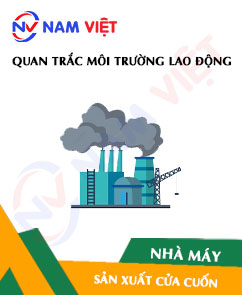
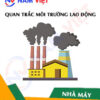
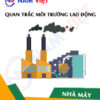
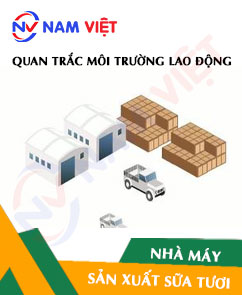





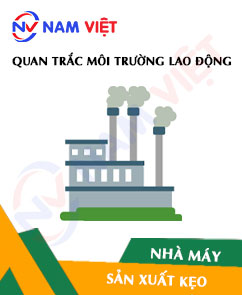

Review Occupational Environment Monitoring at the Rolling Door Manufacturing Plant
There are no reviews yet.